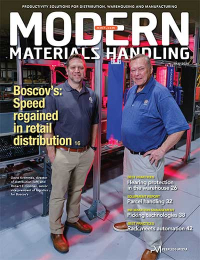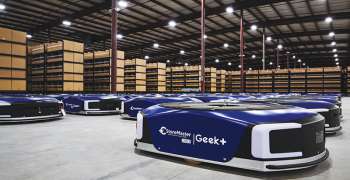Magic Quadrant for Global Third-Party Logistics Providers helps shippers assess global 3PL market
Latest Material Handling News
Agility Robotics brings on CSO, expands other leadership roles Robotics integrator RobotLAB partners with Cyngn for tugger AMRs ALAN prepares for Atlantic hurricane season MHI launches cybersecurity workshop for September Warehouse technology company Synergy Logistics promotes Brian Kirst to Chief Commercial Officer More NewsLike many things, 3PLs (third-party logistics service providers) come in many shapes and sizes. There are myriad things for shippers to consider when evaluating which 3PL to use, including size of company, type of business, value-added services, density, and geography, among others.
Having something to base a wide amount of criteria in the 3PL sector can be challenging for shippers. The Gartner Group’s recent release of its Magic Quadrant for Global Third-Party Logistics Providers aims to help alleviate some of those challenges, which can help shippers to better understand 3PLs and their capabilities when evaluating and selecting a set of providers to meet their needs, according to Gartner.
In its report, Gartner defines a 3PL as “a commercial firm that provides one or more
logistics functions on behalf of its customers as a service for a fee. And to be a 3PL, Gartner said the logistics service provider predominantly operates a business that moves, stores or manages products or materials on behalf of its customer, in some manner, without ever taking ownership of such products or materials. 3PLs provide many traditional services, such as: transportation management and brokerage, warehousing, distribution and fulfillment, air and ocean freight forwarding, shipment consolidation, project logistics, and international logistics management
In evaluating various global 3PL players, Gartner grouped them into various categories, including challengers, players, niche players, and visionaries. And in order to participate in the Magic Quadrant Gartner considered only 3PLs whose depth and breadth could cover regional and multiple service requirements were considered, with the criteria including:
-reported 2011 annual net revenue from logistics services exceeding $1.25 billion (for the purposes of this research, net logistics revenue excludes pass-through transportation revenue);
-generated no more than 65 percent of that revenue from only one of these main logistics services: Transportation management, Warehousing and distribution management or International freight forwarding;
-generated revenue from multiple regions of the world, with no more than 80 percent of that revenue coming exclusively from either the Americas, EMEA or Asia/Pacific (Gartner said the company must derive at least 20 percent of its revenue from regions outside any “home” region; for example, Americas = 17 percent, EMEA = 72 percent, Asia/Pacific = 11 percent.)
Global 3PLs achieving Magic Quadrant status based on Gartner’s criteria included: Expeditors, CEVA, UPS Supply Chain Solutions, and Damco in the Challengers category; Kuehne+Nagel, DHL, DB Schenker, and Agility in the Leaders Category; and UTi, DSV, Pantos Logistics, and SDV in the Nice Players category. No 3PLs were included in the Visionaries category.
“When doing the Magic Quadrant, you are somewhat limited in the number of 3PLs that can be included,” said Gartner Director of Supply Chain Research and Magic Quadrant Co-Author Greg Aimi. “There are about 16-to-20 3PL vendors you can actually evaluate. We started out with 22 that passed the revenue criteria, and whether or not a company was going to participate, we were still going to evaluate them through public information and research.”
Global 3PLs that eventually made the cut for the Magic Quadrant were those that offered a wide breadth of services in a large number of regions with vertical specialization, according to Aimi.
And he added that some of the common themes and drivers in the Magic Quadrant report leverage November 2012 research from Gartner, entitled “Outsourcing Surge Requires a Transformation in Logistics Management.”
Aimi said this report was based on feedback from 3PLs global shipper customers, which was comprised of detailed information of what shippers need and want out of their 3PLs.
The types of shippers served by the 3PLs in the Magic Quadrant are global, multinational, multi-billion dollar corporations, many of whom use dozens of 3PLs.
“There is a bit of futurism in the report, because it is an aspiring goal that companies have in that it is not where they are today,” said Aimi. “The establishment of a preferred set of providers on a global basis is the target. There is no chance these types of shippers have only 1, 2, or 3 providers today, but there is a goal of simplifying the integration between business-to-business and between a shipper and a 3PL, which center around being demand-driven and maturity. 3PLs at the top end realize they are not operating just themselves but that they are operating a network that defines their capabilities. And if that is the case shippers want to integrate their provider globally more easily than it they had 100 3PL partners that is more of an integration challenge for businesses for things like capacity, volume, and inventory.”
And if shippers can expand how they are using 3PLs on a function basis for things like forwarding connected to regional transportation connected to consolidation connected to warehousing and fulfillment—and get 3PLs to show them improvements and cost savings—that is the desired end result, he said.
Getting to that end result was actually expedited by the economic downturn in recent years, according to Aimi.
“It actually helped them to hunker down,” he said. “They were not seeing strong revenues and were discovering how high different systems costs were…and began a huge process globally to integrate systems, processes, and capabilities and standardize them as much as possible globally and specializing regionally when needed.”
The Magic Quadrant report also noted how advancements in technology and associated increases in supply chain visibility and intercompany communications have helped increase the non-asses-based or asset-light 3PL model.
Gartner explained that these are models in which a 3PL uses its expertise and capabilities to offer and manage services using the physical resources of another party (either a carrier’s or a customer’s.

Article Topics
Latest in Materials Handling
Agility Robotics brings on CSO, expands other leadership roles Robotics integrator RobotLAB partners with Cyngn for tugger AMRs ALAN prepares for Atlantic hurricane season MHI launches cybersecurity workshop for September Warehouse technology company Synergy Logistics promotes Brian Kirst to Chief Commercial Officer Seegrid names Abe Ghabra as Chief Operating Officer GRI appoints Ydo Doornbos as its director for North America More Materials HandlingAbout the Author
Subscribe to Materials Handling Magazine

Find out what the world's most innovative companies are doing to improve productivity in their plants and distribution centers.
Start your FREE subscription today.
May 2024 Modern Materials Handling

Latest Resources










